Yesterday was the Immersion 2010 conference at the very central London BIS conference centre. It was a packed room for the entire day. There were a huge range of topics covered and it was particularly interesting as there was clearly a blend of the non gaming virtual world metarati (the usual crowd of us) and game related highly influential academia (Prof Richard Bartle), TV and media Simon Nelson (from the BBC) and Ian Livingstone Eidos/Square Enix (Gaming royalty!) as well as investors and angels. We often don’t have such a mix. The audience were from all over the place too from startups to civil service.
The discussion between Ian Livingstone and Simon Nelson on free vs AAA paid for content with intriguing to see played out. Also Richard Bartle’s views on the sort of education for the games industry was good to hear. A drive needed to do quality education not just games as media studies to attract paying students.
I was on a panel with David Burden (Daden), Ron Edwards (Ambient) and chaired by Mike Dicks (BleedinEdge) Yes we had to have two similar company names, great minds 😉
We talked about the future technology. The room had already had a dip into virtual worlds from the other metarati there with Dave Taylor (Imperial College), Justin Bovington (Rivers Run Red), Michael Schumann (Second Interest) and moderated by Rob Edmonds (SRI).
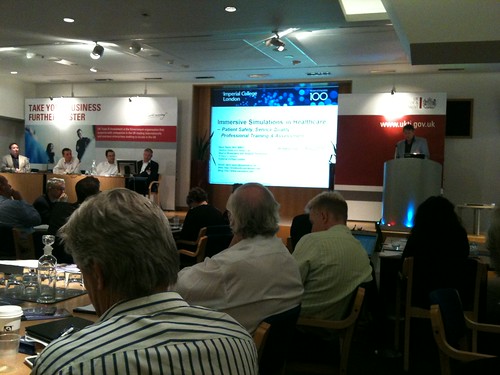
This meant that when I went last in the little 10 min slots we had I decided to push things a little further forward with the ideas I talked about at metameets in Dublin. Boiling down to this picture.
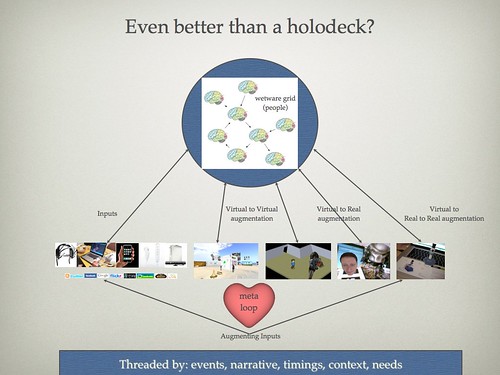
It shows the entire eco system that is really our real and virtual worlds all merged into a collective experience. The point still stands that we should not just replicate the world (though that is part of the equation). We have a whole host of ways to connect and feed one another ideas to show our thoughts and experience them.
I paraphrased Dali, the great surrealist. He stated he wanted to create a dream that was also a living room. A concept that resonates with how I want us to be able to express our ideas and bring understanding to one another powered by our ability to collect and share what we think on the web, to augment wherever we are with more of those ideas. Not restricting ourselves to one layer of AR on top of one physical world. This is a multilayer experience that changes as we need it to. It also encompasses the ability to physically augment our world not just with pixels but with atoms from 3d printers and alike. It is not about a single device or web vs mobile vs games vs outside vs inside. It is everything.
We have already started on this journey, and bearing this picture in your mind or people being truly connected in ways that suit them sits nicely on top of all that is already there on the web and in games and virtual worlds and existing communication technology.
With that post I will head of to a “real” “virtual world” and a family holiday to disney and universal. (You see once you get over making a differentiation and realise its all real life gets a lot simpler 🙂
Monthly Archives: May 2010
3d Printing Good enough for Ironman2
There are some great articles buzzing around about the use of the Objet 3d printers in the production of IronMan2 special effects.
Check out the video description here. Also pay attention to the length of time they have been using it and the fact that this is what the “legacy effects department” does 🙂
More is here
Basically they printed some of the film props and armour based on a quick scan of Robert Downey Jr.
Remember that at the moment this is about CAD models and the specifics of their construction, but we move lots of 3d content around to one another in virtual worlds every day. Simply combine the 2.
HP are moving into 3d printing, and the Object Alaris 30 is a desktop office printer.
Opensim/Second Life Vs Unity3d
I actually get asked a lot about how Unity3d stacks up against Opensim/Second Life. This question is usually based on wanting to use a virtual world metaphor to replicate what Opensim/Second Life do but with a visually very rich browser based client such as Unity3d.
There is an immediate clash of ideas here though and a degree of understanding that Unity3d is not comparable in the usual sense with SecondLife/OpenSim.
At its very heart you really have to consider Opensim and Second Life as being about being a server, that happens to have a client to look at it. Unity3d is primarily a client that can talk to other things such as servers but really does not have to to be what it needs to be.
Now this is not a 100% black and white description but it is worth taking these perspectives to understand what you might want to do with either type of platform.
Everything from an Opensim style server is sent to all the clients that need to know. The shapes, the textures, the position of people etc. When you create things in SL you are really telling a server to remember some things and then distribute them. Clearly some caching occurs as everything is not sent every time, but as the environment is designed to be constantly changing in every way it has to be down to the server to be in charge.
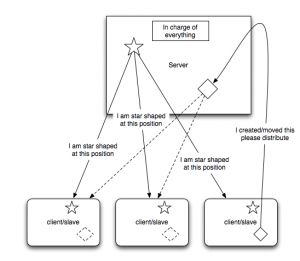
Now compare this to an “level” created in Unity3d. Typically you build all the assets into the unity3d file that is delivered to the client. i.e. its a stand alone fully interactive environment. That may be space invaders, car racing, a FPS shooter or an island to walk around.

Each person has their own self contained highly rich and interactive environment, such as this example. That is the base of what Unity3d does. It understands physics, ragdoll animations, lighting, directional audio etc. All the elements that make an engaging experience with interactive objects and good graphic design and sound design.
Now as unity3d is a container for programming it is able to use network connectivity to be asked to talk to other things. Generally this is brokered by a type of server. Something has to know that 2,3 or many clients are in some way related.
The simplest example is the Smartfox server multiplayer island demo.
Smartfox is a state server. It remembers things, and knows how to tell other things connected to it that those things have changed. That does not mean it will just know about everything in a unity3d scene. It its down to developers and designer to determine what information should be shared.
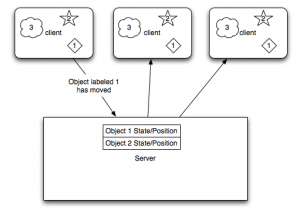
In the case above a set of unity clients all have objects numbered 1, 2 and 3 in them. It may be a ball, a person and a flock of birds in that order.
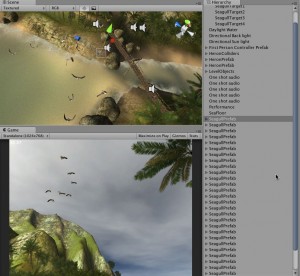
When the first client moves object number 1 smartfox on your own remote web server somewhere in the ether is just told some basic information about the state of that ball. Its not here now its here. Each of the other unity clients is connected to the same context. Hence they are told by the server to find object number 1 and move it to the new position. Now in gaming terms each of those clients might be a completely different view of the shared system. The first 2 might be a first person view, the thirds might be a 2d top down map view which has no 3d element to it at all. All they know is the object they consider to be object number 1 has moved.
In addition object number 3 in this example never shares any changes with the other clients. The server does not know anything about it and in the unity3d client it claims no network resources.
This sort of game object is one that is about atmosphere, or one that has no real need to waste network sending changes around. In the island example form unity3d this is a flock of seagulls on the island. They are a highly animated, highly dynamic flock of birds, with sound, yet technically in each client they are not totally the same.
(Now SL and Opensim use principle this for things such as particles and clouds but that is designed in)
For each user they merely see and hear seagulls, they have a degree of shared experience.
Games constantly have to balance the lag and data requirements of sending all this information around versus things that add to the experience. If multiplayer users need to have a common point of reference and it needs to be precise then it needs to be shared. e.g. in a racing game, the track does not change for each person. However debris and the position of other cars does.
In dealing with a constantly changing environment unity3d is able to be told to dynamically load new scenes and new objects in that scene, but you have to design and decide what to do. Typically things are in the scene but hidden or generated procedurally. i.e. the flock of seagulls copies the seagull object and puts it in the flock.
One of the elements of dealing the network lag in shuffling all this information around is interpolation. Again in a car example typically if a car is travelling north at 100 mph there if the client does not hear anything about the car position for a few milliseconds it can guess where the car should be.
Very often virtual worlds people will approach a game client expecting a game engine to be the actual server packaged, like wise game focused people will approach virtual worlds as a client not a server.
Now as I said this is not black and white, but opensim and secondlife and the other virtual world runnable services and toolkits are a certain collection of middleware to perform a defined task. Unity3d is a games development client that with the right programmers and designers can make anything, including a virtual world.
*Update (I meant to link this in the post(thanks Jeroen Frans for telling me 🙂 but hit send too early!)
Rezzable have been working on a unity3d client with opensim, specifically trying to extract the prims from opensim and create unity meshes.
Unity3d and voice is another question. Even in SL and Opensim voice is yet another server, it just so happens than who is in the voice chat with you is brokered by the the main server. Hence when comparing to unity3d again, you need a voice server, you need to programatically hook in what you want to do with voice.
As I have said before though, and as is already happening to some degree some developers are managing to blend thing such as the persistence of the opensim server with a unity3d client.
Finally in the virtual world context in trying to compare a technology or set of technologies we actually have a third model of working. A moderately philosophical point, but in trying use virtual worlds to create mirror worlds at any level will suffer from the model we are basing it on, name the world. The world is not really a server and we are not really clients. We are all in the same ecosystem, what happens for one happens for all.
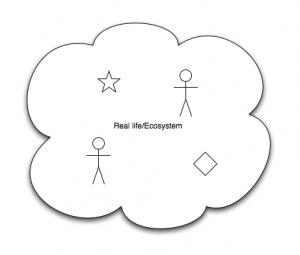
Time to get immersed : Serious Games Conference
This coming monday is a day of conference speaking and listening, swapping some more business cards and catching up with yes more metarati. It’s Martine Parry’s Immersion (formerly Apply Serious Games) 24th May at the DTI/BIS conference center.
I will be on the panel speaking about “What are the Game-Changer Technologies? How are New Techniques Opening Opportunities for the Future? Augmented reality. 3D technologies. Intelligent Systems. Player Matching.”
So for those that missed metameets, or want to hear some of us talk about a highly likely, highly really and almost scary future come on over 🙂
As usual if there are some things you want to ask on this subject, please comment, tweet, SL etc me.
If you see me at the event come say hi 🙂 I will of course be in my usual jacket and with my recent experimental feedingedge tshirt print.
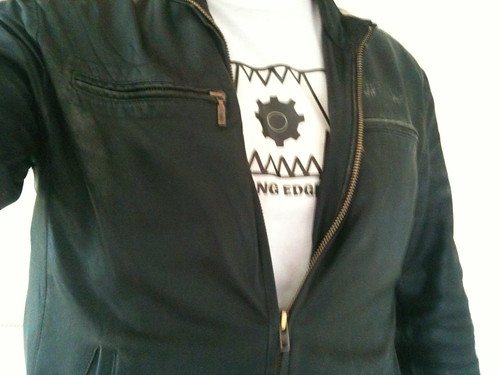
I should also be able to see you all now, as new glasses are in full working order.
All in all should be a good day.
Why metameets 2010 rocked
Why did metameets 2010 rock so much? The answer is simple, it is the same one I gave to John Mahon’s initial question on day one for what the killer app is for virtual worlds. People. Too often a conference will be about an particular product or artefact that needs to be sold/monetized/promoted. In the case of metameets, whilst there is a heavy Second Life focus, it is about us all connecting with one another. Some of that involves close proximity of one another’s carbon atoms gathered in a physical location, however lots of it was powered by people being present from wherever they happened to be at the time.

Clearly we are all enthusiastic about the use of virtual worlds and its related tech as a medium for the things we do. Also we are very tolerant and understanding of the various ways locations real and virtual got connected. We knew the tech would not always work, however the team how put it all together and made it run had so many bases covered it was very impressive.
Consider what was actually going on.
1. A group of early adopters fly in from all over the place to be at the Dublin Institute of Technology, many who know one another from purely online interactions and the mini fame bubble we have in all this.
2. A group of early adopters drop into the sim in Second Life where video from the DIT is streamed in.
3. The video of both Second Life and DIT is also streamed/recorded to a web chatroom
4. Some speakers present in Second Life as a talking head, some present as a more TV style chat show interview format.
5. Some speakers present in the DIT, mixture of slides, body language, stage performance etc.
6. Some speakers present as a Skype stream mixed with slides.
7. The whole thing gets threaded on twitter with a #metameets hashtag
8. Inworld chat in SL, and twitter, and web chat, and skype and physical voice are all used to present questions to speakers wherever they happened to be.
People in the physical room were also engaged with the online parts, some people in world, some on twitter etc.
How many conferences have you been to where there is not even a web stream, or a suggested hashtag, where the whole thing has been designed to be closed off. This was 100% open.
The team were both in the conference and organizing it, and as participants were were equally enabling and helping. A whole set of people were also not in Ireland but directing the streams from elsewhere
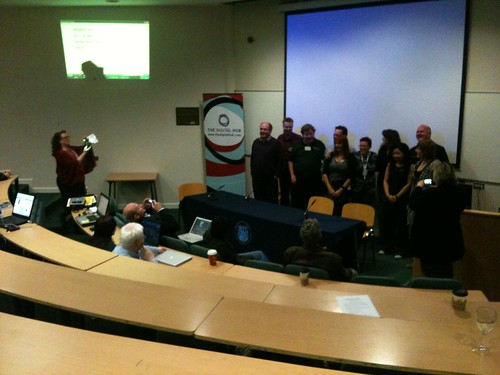
We realised that sometimes the remote presentations either direction meant we were a little detached form one another atmosphere wise. However, those are solvable. I was not in SL very much as I happened to not sit by a power socket, so it really was a very old fashioned problem of needing more electricity (we had wifi) to then engage in SL or webchat. I did though use my iphone a lot on the wifi to engage on twitter.
So not only did we have very interesting people saying very interesting things, we were doing it in the ecosystem that we all talk about and thrive in. After a talk people would go for a break, gather in small groups and chat about things, just as the groups in SL and wherever else were able to gather and chat. Chat sounds like a trivial word, but really it was to extend one another’s understanding, to challenge and support the various conversations, to share war stories.
The threads that came together though were so intriguing. The first night in Gogharty’s pub in Temple bar, talking with Ham Rambler about how his very famous Dublin in SL came into being. How the Blarney Stone in SL was modelled on the pub we were in. For me that had lots of serendipity, not least because the builder of said Dublin in SL was originally Robin Winter/Shukran Serendipity who now works at Imperial College with Dave Taylor/Daveee Commerce and who I have been working with on some medical training sims. The blarney stone also featured in one my earliest evangelist moments helping a client persuade the rest of his team about the benefits of virtual worlds, in particular the mirror world aspect. He described to me in front of them how I would reach this pub using verbal directions only. I then sparked up SL and turned the very corners he described to arrive at the Blarney Stone. They then almost 100% got that particular point.
So to all the organizers, speakers and attendees I have to say a huge thankyou. It is so nice to be amongst friends sharing ideas and leaving feeling motivated.
For me it was a great honour to do my pitch, to think some thoughts and also to do them as almost a warmup act for Philip Rosedale who was on straight after me.

Thankyou JojaDhara for inviting me to speak (via my old colleague Rick Reesen 🙂 )
Well done to Malburns and the crew for the remote TV studio direction and wrangling too 🙂
Slimwarrior and BevanWhitfield for seemingly powering the entire place with frantic keystrokes and electric enthusiasm.
Sitearm Madonna for keeping it all on the straight and narrow, and asking some damn good questions.
Other things and people you really should check out.
StuWarf should be an inspiration to us all. As he pointed out he probably was the youngest person in the room, yet he has driven into existence a whole business with Rezzed.tv whilst still being a student. I hope he will be at the next metameets and get to present his life experience to us too.
Chantal/MaMachinima and her marvellous machinima that the edit her pieces of work certainly bounced around with my emotions , a few brought a lump to my throat, others made me laugh. It is very inspiring too that her work has been show at the world expo in Shanghai.
Slimwarriors album Slimgirlfat is on itunes, I know that because I am listening to it now whilst typing this 🙂
It was brilliant to hear Lisa Feay/Elfay Pinkdot’s rant/monologue/empassioned plea and list of words she never wants to hear again (monetize anyone?). Her radio show and Jazz geek out is worth checking out http://www.coffeeandpajamas.com/
Claus Uriza and his pop art lab are certainly worth hearing more about and visiting.
On the tech side of things it was great to catch up with my fellow colleague at the old firm and travel with justincc. He is Mr opensim and it was great to see him in the mix and hearing some cool things to geek out to.
Jon Himmoff of Rezzable had some very interesting things with opensim and unity3d to talk about and show. Something dear to my heart, that kind of integration.
Now of course I realize that this post could go on and on, Jessica Pater, Tim Savage, Paul McDonagh-Smith, Tim Goree, Justin Bovington, Robin Harper, Joel Foner, Mark Kingdon, Philip Rosedale ….. all had cool things to say.
Who could not though be inspired by all this? All in the beautiful city of Dublin.
So yay for bangers and mash
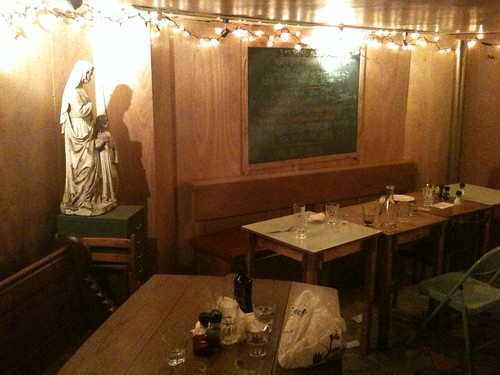
Rock and roll fish and chips

(I hope epredator makes it onto the roll of honour up there with U2 🙂
Guinness and the Blarney Stone/Gogharty’s

The megaprim needle in the centre of Dublin

My one concern is that somehow we may have excluded some of our virtual world peers as they seemed to be a little annoyed and have made a film about it.

Next year more furries in RL please. Thankyou……
Helping organise thoughts, and speaking freely
Once again for my pitch at metameets I used a little bit of virtual world technology as a mental aid to help me figure out what it was I was going to say and in what order. I am finding thins an increasingly useful technique, so as this is the second time around for it I thought I would explain it again.
I created the presentation in the usual fashion a set of keynote/powerpoint slides, mostly because I had ones from other presentations that I wanted to thread in and re-use. Once I had the single threaded narrative sorted, and the slide in the right order a structure, for what is in effect a story, appeared.
In order to preserve this structure I took images from all the slides and put them into my local Opensim.
Once in there these simple flat panels take on a relationship to one another that just does not happen when you are flicking from slide to slide.

In the picture above the pitch really started at the back. The back row is the underpinning, an introduction. Seven related slides to go through at any pace, but ideally quite quickly.
Next is a challenging step forward, as the next row comes forward. To support that is a another row, which is held to the side a little as it is really optional. In this case its a slide about how it feels to attach things to your avatar. That allows free expression, no script but just a memory of a feeling.
Then the next row is group into three groups. This is a change of pace, a set of ideas with an example in each of the three.
Then the penultimate row as you come forward is the tying it all together picture. Ideally by the time I get here the other 3 ideas have started to make a little sense.
Then there is the final slide to finish on.
Rather than sit and read the slides or over rehearse I just had this image on my iphone of the layout. It is enough that I can see the sort of pages I had created and when presenting I can think where I am in the flow. So if there is some sort of distruption, or an idea that comes to mind whilst talking I can think quickly as to where it will fit in or if it has missed its chance.
This is really just storyboarding meets mindmapping, but the multiple dimensions of it and the visual memory of having been there is incredibly powerful and I recommend anyone try and structure some thoughts or ideas or keypoints in some way like this to see how it feels.
Does anybody else do this, I would love to hear stories about it ?
Not all avatars and islands – Metameets 2010
I am over here in Dublin this weekend for a very good gathering and conference Metameets 2010. I was lucky enough to be able to present yesterday, and as I mentioned in a previous post I decided to suggest we had some more places and directions to go.
The underlying premise of this is that a thread of narrative, and event, a set of ideas do not have to live in one virtual world or in one place. Threading and augmenting physical and virtual and web in multiple ways may start to give us new metaphors for connecting our ideas and improve human communication online. This is because though I love virtual worlds at the moment, and they are not going away, I know there is more we can do, better ways still to use all the ways we can interact and engage. It’s not all avatars and islands.
What was a great honour too was to effectively be the warmup act for Philip Rosedale, talking about Love Machine and Mark Kingdon talking all things Linden Lab/SL. Both those presentations were streamed in. In fact quite a few in the afternoon had to be streamed in due to the ash cloud stopping some travel.
I will write a post on the whole experience and some thoughts once we are done, but for now the slideshare of my pitch is up.
One of the anecdotes to describe this that came to my whilst I was talking was to consider being in an irish pub, with the band playing and wanting to join in on the penny whistle. You don’t have one to hand so you quickly check out the virtual world shops and find one you like, 3d print it out in the pub, join in and then find the whole thing is captured and streamed into another virtual world, like the blarney stone in Dubln SL. It’s not one place or one experience.
Social commentary on privacy 100 Robots style
It is well worth checking out 100 Robots, this video Jim Purbrick just posted is really well put together, a catchy song with a bite of social commentary and some great mixing in with Aleks’s interviews from the Digital Revolution (I still have not managed to get to a live gig much to my own annoyance)
” song about biometrics, click tracking, online privacy, Phorm, governmental data loss, corruption and the surveillance state. Features interviews with Chris Anderson, John Battelle, Sherry Turkle and Lee Tien from the BBC Digital Revolution rushes. Filmed and directed by Chris Cole.”
Nice work I think. The lyrics indicate the potential benefit that someone has of providing a “free” service but that we pay with with our information, our Kudos, our time or our support. Done well of course it can be for common good. Done badly, i.e. like a government system that loses data, or where information is abused for profit to the detriment of others, it is a concern.
Of course you can just sing along with the hook 🙂
Open source software really has come of age
The past few weeks I have had my head in an installation of Drupal 6.16 the content management system that sits very nicely on the LAMP stack. So I got to spark up another Ubuntu linux server off in a cloud somewhere,using the great apt packager on ubuntu/linux to go and fetch the extras I needed AND their dependencies. All the extra instructions I needed were on slicehosts forums for various pieces of config. So a full OS, all the extras I needed without having to trawl trough patches and dependency trees manually. In the good old days the stuff was pretty disorganised. If you came to it all fresh, or had been away for a while the “obviously you would have x, y or z” would be quite a pain.

The whole apache, mysql, php installation and config is also very straightforward. Yes you still need to know a few of the more arcane system command lines, or be able to look them up and editing even with nano or vi on a terminal is still rather annoying (terminals being a hangover from before we had more complex machines on the front end of servers). However, doing what would be the simplest task in a drag and drop world in a command line typing all the paths correctly etc makes you feel you are in charge of the whole thing. Which is why sysops are usually quite stroppy 🙂
Drupal’s install goes like a dream to. Again a whole set of extra modules are contributed to the let you do other things with your content, thinks like the CCK (content creation kit) which layers some new fields to be able to add to the page creation forms you make.
Back in 1998 I wrote content management systems, mainly in Lotus Domino, I know the problems and also the sort of things you need to do in the systems. So for me Drupal was great, once you get used to the naming convention of the template overrides and the ability to use views (SQL selects) on the data its all pretty slick. It is of course a long while since 2008, and it is interesting that whilst there were lots of commercial CMS packages that attempted to emerge none of them seem a patch on Drupal and even on WordPress. That is for most things, most web applications it is a pretty good fit.
Of course with any themeable template based system with a multitude of user contributed modules and gadgets there are going to be times when things just are not where you need them to be for your particular layout or information design. I spent a fair bit of time with one piece of data and layout trying to do it “properly” in the end I just changed the module, which let me put the class id’s in that I needed to make more sense of the display for the CSS. Not ideal but the point was it was there to do.
Commercial software has all to often been put in place to keep you away from the engine. Opensource be it opensim, drupal, wordpress, linux, freeswitch etc really do let you be the mechanic on the engine if you want, but you clearly don’t have to as the slickness of the design ethics in these applications through crowdsourced cooperation is quite stunning.
To do the full thing from commissioning a server to creating data structures in Drupal and then adjusting templates and style sheets is still a great swathe of skills needed, but when you have been in this for so long you know the patterns and roughly how things need to work. The ability to look up and search for problems, similar situations and generally fix on the fly though really helps to and can’t be understated. Much better than routing through a cupboard of manuals as we had to back in 1990!
Gotta love the web
